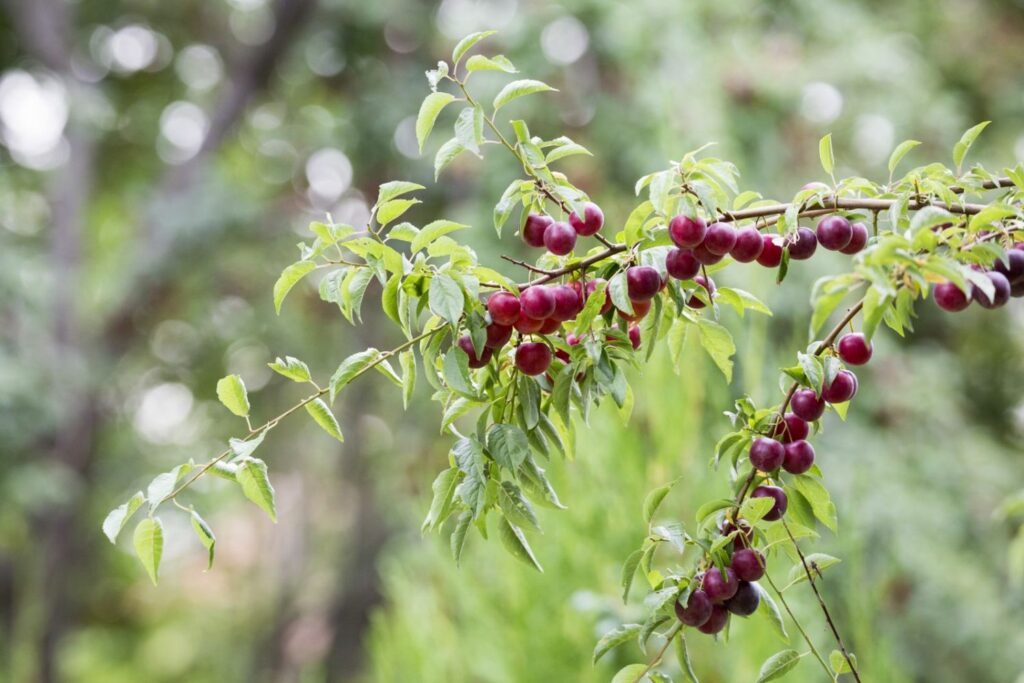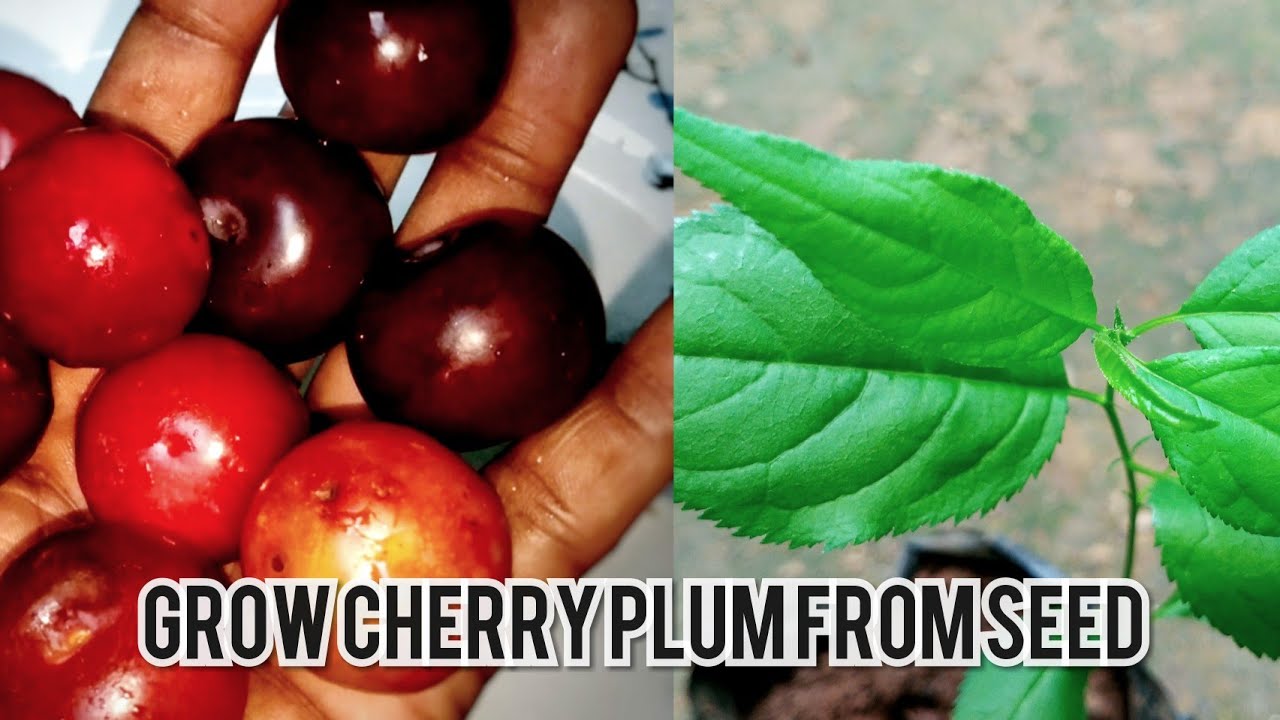For me plants are some of the most exciting living beings, even though they live in slow motion. They have fascinating abilities and just so much potential! Thats why I studied organic farming. But because there aren’t many plants in my city, I like to go hiking in the nearby mountains on the weekends. In the future I would love to run a farm myself. Favourite fruit: strawberries and gooseberries Favourite vegetable: courgettes.
Cherry plum trees are one of the first trees to blossom in spring. Find out everything you need to know about cherry plum trees and how to grow one in your yard.
If you’ve ever tried a cherry plum, you may have thought it was pretty sour. But don’t let that stop you—there are sweet kinds too. Find out more about cherry plum trees, how to take care of one in your garden, and which kinds of cherry plums are the best to eat below.
Cherry plums are small, attractive fruit trees that produce abundant crops of sweet, tangy plums in summer. Though not as well known as conventional plums, these underrated fruits are easy to grow and deserve a place in any edible garden. Here is a complete guide to growing cherry plum trees.
Overview of Cherry Plums
Let’s start with a quick introduction to cherry plum trees:
-
Small ornamental trees that grow 15-20 feet tall and wide. Attractive blossoms in early spring.
-
Produce clusters of cherry-sized plums in summer. Flesh can be yellow red or purple. Sweet tangy flavor.
-
Extremely hardy. Thrives in zones 3-9. Can handle cold winters and hot summers.
-
Easy care. Tolerates most soil types and needs little pruning or intervention once established
-
Plums ripen over several weeks. Frequently drop when ripe, so enjoy them right off the tree.
-
Best for cooking and preserves like jams, chutneys, pies. Not great for fresh eating.
Selecting a Cherry Plum Variety
There are a few popular cherry plum cultivars to choose from:
-
‘Gypsy’ – deep red skin and flesh. Sweet flavor perfect for jam. Partially self-fertile.
-
‘Early Laxton’ – heavy yielding. Yellow flesh tinged red near the skin. Reliably produces fruit.
-
‘Blue Tit’ – large blue-black plums. Heavy crops. Partially self-fertile.
-
‘Katinka’ – red skin, yellow flesh. Very sweet. Good for eating fresh. Self-fertile.
-
‘Thundercloud’ – large dark plums. Reliable producer. Self-fertile. Hardy and robust.
Consider pollination requirements when choosing varieties. Many cherry plums need a pollination partner but some newer types are self-fertile.
Growing Cherry Plums from a Nursery Tree
Starting with a young potted tree from a nursery is the easiest way to get growing:
-
Plant in spring after the last frost. Choose a sheltered, sunny spot with well-draining soil.
-
Dig a hole the depth of the root ball and twice as wide. Set the tree in and fill around with soil, lightly tamping down.
-
Water deeply after planting and whenever soil is dry the first year. Add mulch around the base to conserve moisture.
-
Stake the young tree for the first year until it establishes a solid root system.
-
Prune lightly in late winter to shape, removing any dead or damaged branches.
Growing Cherry Plums from Seed
You can also grow cherry plum trees from the pits inside the fruit:
-
Collect ripe plum pits in late summer. Clean off the flesh and let pits dry for a few days.
-
Stratify pits by placing in moist perlite or sand in the refrigerator for 2-3 months.
-
In late winter, plant pits 2 inches deep and 6-12 inches apart in pots or seed trays. Keep soil moist but not soaked.
-
Grow on the seedlings over summer, transplanting into larger pots as needed.
-
The following spring, transplant cherry plum trees into their permanent position outside.
Caring for Cherry Plum Trees
Once established, cherry plum trees need minimal care:
-
Water young trees regularly, but mature plants only need watering during droughts.
-
Apply a balanced organic fertilizer or compost in early spring when growth resumes.
-
Prune annually in late winter to maintain shape and thin overcrowded branches. Don’t over-prune.
-
Weed and mulch around the base to reduce competition. Avoid mounding mulch against the trunk.
-
Check for common plum pests like aphids and treat organically if needed. Most issues are minor.
Pollination Requirements
Most cherry plums need cross-pollination from another compatible cherry or plum tree flowering at the same time:
-
Plant different varieties within 50 feet of each other for successful pollination.
-
Self-fertile varieties like ‘Katinka’ and ‘Thundercloud’ will set fruit without a pollinator.
-
European and Japanese plums can pollinate cherry plums when blooming together.
-
Heavy crops on cross-pollinated trees since more flowers are fertilized and set fruit.
Harvesting and Storing Cherry Plums
-
Pick plums when fully colored but still firm. Leave to ripen further on counter.
-
Ripe plums fall easily from tree. Pick up windfalls daily and use quickly before they spoil.
-
Store fresh plums in refrigerator no more than 3-5 days. Best preserved by canning, freezing, or processed into jam.
-
Yields range from 25-100 lbs per mature tree depending on variety and care. Smaller harvests from young trees.
Common Pests and Diseases
Cherry plum trees are quite robust, but may be affected by:
-
Aphids – Control with insecticidal soap or strong sprays of water. Avoid over-fertilizing.
-
Plum moths – Pick up and discard fallen fruits to prevent wormy plums. Cover fruits with netting.
-
Brown rot – Improve air circulation. Thin fruits and avoid overcrowding. Remove infected fruits.
-
Bacterial canker – Only plant disease-resistant varieties like ‘Blue Tit’ or ‘Thundercloud’.
-
Cytospora canker – Prune out infected branches. Improve air flow. Keep trees vigorous.
Enjoying Versatile Cherry Plum Fruits
Cherry plum trees are easy to grow, widely adaptable, and deliver good crops of fruit for cooking. A mature tree can produce bushels of plums, enough for dozens of jars of jam, chutney, syrups, and more. Give this underappreciated fruit tree a try in your own edible garden!
Are cherry plums edible?
Yes! As cherry plums are by no means poisonous, they are indeed edible. You can eat the fruit straight from the tree just like mirabelles and plums. Whether the fruits taste good is another matter and largely depends on the tree variety. While some trees bear exquisite, flavourful fruit, other cherry plums can taste rather bland. So, before you go to the trouble of picking cherries from a tree, try one to see if you like it.
Cherry plum trees: origin & characteristics
Cherry plum trees (Prunus cerasifera), which are sometimes called myrobalan plums, have been around for more than a thousand years. The Celts even knew about them. In fact, the cherry plum tree is older than the plum tree (Prunus domestica). We know this because the plum was first made by crossing a sloe (Prunus spinosa) with a cherry plum. These deciduous trees originated from Central Asia, and were later introduced to Europe. Cherry plum trees are often found in orchard shrubberies because they are often used as rootstock for grafting different types of Prunus trees.

Cherry plum trees don’t get very tall—only 8 meters—but they get pretty wide, and their crowns can even have more than one stem. Cherry plum leaves are up to 7 cm long and have fine serrations. They grow from thin branches, some of which have thorns on them.
Cherry plum trees bloom with strongly scented flowers in the spring, even before the closely related sloe and mirabelle plum trees (Prunus domestica subsp. syriaca). Cherry plum blossoms are white with a hint of soft pink on the inside. As trees that bloom early, cherry plums are very important to many insects because they provide food when there isn’t much else around.
how to grow cherry plum tree from seed .| Grow cherry plum from pit .
FAQ
Can I grow a cherry plum from a pit?
How long does it take for a cherry plum tree to produce fruit?
|
Fruit Tree Type
|
Years to Bear
|
|
Pear Trees
|
4-6 years
|
|
Persimmon Trees
|
3-4 years
|
|
Plum Trees
|
3-6 years
|
|
Pomegranate Trees
|
2-3 years
|
Where do cherry plum trees grow best?
How to care for a cherry plum tree?
How do you care for a cherry plum tree?
Their shrub-like/dwarf fruit tree stature makes harvesting and growing a cherry plum plant easy. Cherry plum care is just like care for any cherry or plum tree. They prefer sandy soils and should be watered in times of drought. Many varieties of cherry plum require a nearby cherry or plum tree for pollination in order to bear fruit.
What is a cherry plum tree?
Depending on whom you ask, you may get two very different answers. “Cherry plum” can refer to Prunus cerasifera, a group of Asian plum trees that are commonly called cherry plum trees. It could also refer to the hybrid fruits which are literally a cross between plums and cherries. How to grow cherry plum trees also depends on which one you have.
How long does a cherry plum tree take to grow?
Cherry plum trees are primarily grown for ornamental purposes, but they can easily produce fruit within two to four years of planting if placed near the correct pollinators. These trees can grow in both temperate and subtropical climates, reaching a height of 15 to 20 feet and a canopy width of about 20 feet at full maturity.
Can cherry plum grow in clay soil?
A quick note is to never plant your cherry plum in a spot where alkaline and salt are concentrated. Clay soil, too, is a complete fail for your cherry plum plant. Cherry plum plants naturally need full sun or light shade to grow optimally. Sufficient sunlight for this plant is required for photosynthesis in its growth.
- The Ultimate Guide to Growing Strawberries in Raised Beds - August 8, 2025
- No-Dig Garden Beds: The Easiest Way to Grow a Beautiful Garden - August 6, 2025
- How to Protect and Preserve Wood for Raised Garden Beds - August 6, 2025

